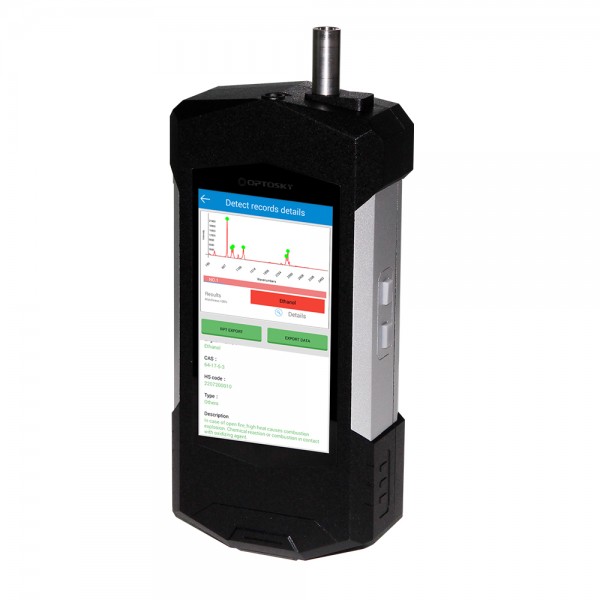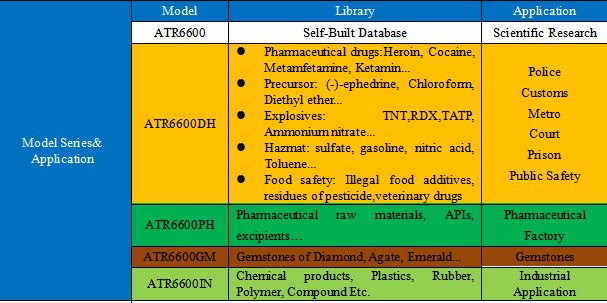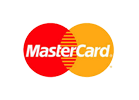ATR6600 is a set of 1064nm handheld Raman analyzer that excels at fluorescence resistance suit to high fluorescence materials detection.
With a compact size, lightweight (<1.2kg), and easy-to-hold, it can be widely applied to industries of customs, public safety, lab, plant, warehouse, deck etc. It can fast detect drugs, precursor chemicals, explosives, gemstones, raw materials, and also fast identify additives, residues of pesticide & veterinary drugs.
Excellent spectral identification algorithm is embedded in Handheld Raman spectrometers to easily identify the substance, and enable users to add their own spectral data. It employs an Android system,simple interface,5.5" high definition screen, 13-mega camera taking evidence pictures in the field, multiple modes of inbuilt WIFI, Bluetooth, GPS, etc.
Optosky provides full technical support and services, including spectral library building, method & verification, 21 CFR 11 complaints, IQ/OQ/PQ validation, etc.
Intelligent Mobile Instrument Available in Your Hand!
Order Guide:
| Raman Spectrometer System Parameters | |
| Interface | WIFI, USB Type-C, Bluetooth, GSM |
| Operating System | Android |
| Operating temperature | -20 – 50 ℃ |
| Dimension | 220×110×45mm |
| Weight | 1150g |
| Touch Screen | 5.5",1920×1080,Multi-point touch control |
| Export Report | Excel at Fluorescence Resistance |
| Battery | 8 hour |
| Charging Type | USB Type-C |
| Library | Abundant Library and self-built library for selection. KnowItAll or ST Japan purchase library |
| Raman Spectrometer Optical Parameters | |
| Spectral Range | 200-2800 cm-1 |
| Resolution | 8-12cm-1 |
| Raman spectrometer Detector | |
| Detector Model | TE cooled InGaAs |
| Cooled down to | -20 |
| Dynamic range | 14000:1 |
| Pixel Size | 25×50μm |
| Raman Spectrometer Laser Parameters | |
| Excitation Wavelength | 1064 ± 0.5nm |
- 1064nm Excitation,Reduced Risk of Fluorescence Interference;
- Non-Destructive, Fast Detect & Identify, One-touch Operation;
- The advanced algorithm, mixture detection;
- HD 5.5" capacitive touch screen, smooth operation system;
- 13-mega camera;
- Barcode & QR scan
- Precision GPS positioning;
- Multiple modes of 4G, GPS, GPRS, Bluetooth, WIFI
- Self-Built Spectral Library
- Test results report export pdf
- Built-in Li-battery continuous operation 4-6hrs
- Lightweight(1.2 kg),easy-to-take
- IP-68 Jacket, grip
- Public Safety;
- Food Safety;
- Dangerous Chemicals Detect at High-Speed Train, Metro Entrance
- APIs & Pharmaceutical Excipients;
- Gemstones & Materials Identification,
- Mineral sorting
- Experimental Research;
- Antique authentication;
Q - What is Raman spectroscopy?
A - In Raman spectroscopy, an unknown sample is illuminated by a monochromatic (single wavelength or single frequency) laser, which can be absorbed, transmitted, reflected, or scattered by the sample. The light scattered from the sample is caused by the elastic collision (Rayleigh scattering) or inelastic collision (Raman scattering) of the light with the sample molecules. Rayleigh scattered light has the same frequency (wavelength) as the incident laser light, and when Raman scattered light returns from the sample, it is affected by the vibration of molecular bonds in the sample, and the frequency of the scattered light changes compared to the incident light.
Q - How to use Raman spectrum in pharmaceutical Industry?
A - In pharmaceutical production, Raman spectrometers are suitable for the inspection of incoming raw materials, the allocation of materials during API production, and the identification of counterfeit and inferior products.
Pharmaceutical manufacturers use Raman spectrometers for raw material analysis in pharmaceutical manufacturing processes. Even non-professional operators can use hand-held Raman analyzers to quickly and accurately identify raw materials.
QA / QC applications for Raman analyzers include enhanced raw material authenticity checks for similar compounds, multi-component authenticity checks, and identification and quantification of intermediate and finished products. In PAT, specific applications include on-line end determinations for distillation, reaction monitoring, and powder mixing operations.
Counterfeit or substandard drugs are a growing problem worldwide. To protect patient and brand integrity, pharmaceutical manufacturers use portable Raman analyzers to identify counterfeit products. The portable Raman analyzer allows users without chemical training to conduct on-site screening of drug samples and quickly and accurately identify counterfeit or substandard drugs. Because the spectrum generated by TruScan RM is able to check all the ingredients in the pharmaceutical dosage form: API, excipients, fillers, dyes, coatings, etc. to produce a spectrum representing all ingredients (and their relative concentrations), any slight deviations from the original Both will cause the obtained spectrum to change. This makes ATR6500 the ideal tool to quickly detect counterfeit and inferior medicines in the field.
Q - What is the correlation of Raman spectroscopy with high-throughput screening in the pharmaceutical industry (HTS) ?
A - High-throughput screening (HTS) used in the pharmaceutical industry involves testing the collection of hundreds of samples and subsequent analysis to quickly determine the biological or biochemical activity of a large number of drug-like compounds. HTS technology is used to characterize polymers and drugs by integrating itself into the manufacturing process to provide real-time measurements. Due to the large number of samples, HTS requires a high degree of automation and a small number of sample preparation steps. Raman spectrometers meet this need and are widely used to automate HTS and analytical measurements.
Q - Can only scientists or experts use Raman technology in pharmaceutical and pharmaceutical production?
A - Some handheld Raman analyzers used in the pharmaceutical industry are specifically designed and set up for non-expert users. For example, the ATR6600 pharmaceutical handheld Raman analyzer can not only obtain the Raman spectrum of the target material, but also determine the measurement uncertainty in real time, giving relevant factors such as sample characteristics, instrument telemetry, environment, and test environment. End users of field material identification systems are usually not spectroscopic experts, so instrument data can be relied upon to convert instrument data to qualitative results.
Q - Is Raman spectrosopy suitable in USP & EP?
A - The ATR6600 Handheld Raman Spectrometer fully complies with the revised standards USP General Rules for Raman Spectroscopy <1120>. The ATR6600 enhances 21 CFR Part 11 compliance security features, such as biometric login and optional password aging and complexity, allowing users to customize the analyzer's security settings beyond regulatory requirements.
Q - Can Raman spectrometers be used to analyze tablet film coatings?
A - Pharmaceutical companies that produce tablets, capsules, and other solid dosage forms need to use film coatings on their products to differentiate the visual appearance, improve swallowing ability, and mask unpleasant tastes or odors. Film coating can also reduce cracking and chipping of tablets and provide protection from light, humidity and ambient gases. The latest handheld Raman analyzers have built-in multivariate residual analysis decision tools to identify most materials, while more complex materials analysis requires users to build custom advanced algorithms. Some handheld analyzers use built-in chemometric configurations to enable users to develop customized predictive applications, including classification, semi-quantitative, and quantitative methods, to establish pass / fail criteria to identify highly similar compounds such as tablet packs clothes).
Q - Can Raman spectroscopy be used to verify stearates and other pharmaceutical capsule lubricants?
A - Magnesium stearate is a white powder that turns into a solid at room temperature. In pharmaceutical manufacturing, magnesium stearate is the most commonly used capsule and tablet lubricant to help prevent pharmaceutical ingredients from adhering to manufacturing equipment. Calcium stearate, and to a lesser extent, zinc stearate, are also used as pharmaceutical excipients in the production process, mainly for the lubrication of tablets and capsules.
Magnesium stearate, calcium stearate, and zinc stearate have similar compound structures, so validation during the feed inspection process is more challenging. Although some pharmaceutical industry handheld Raman analyzers have built-in multivariate residual analysis decision tools to identify most materials, more complex materials analysis requires users to build custom advanced methods. Those using a built-in chemometric configuration of the Raman analyzer enable users to develop customized predictive applications, including classification, semi-quantitative, and quantitative methods, enabling users to build models that can be applied to the analyzer.
Q - Can Raman spectrometers analyze drugs through packaging?
A - Yes, the latest handheld analyzers can scan through plastic bags, glass containers, clear plastic covers, and clear plastic covers. These analyzers' point-and-measure sampling is non-contact and non-destructive, minimizing the risk of cross-contamination and operator exposure.
Q - Is Raman spectroscopy method dangerious?
A - In Raman spectroscopy, a sample of unknown material is illuminated with a monochromatic (single wavelength or single frequency) laser. The danger of using high-power lasers must be recognized, especially when their wavelengths are in the near-infrared region of the spectrum, because they are not visible to the naked eye at this time. Fiber optic probes should be used with care and refer to relevant government regulations regarding lasers and laser classification.
The laser used in Optosky's ATR6600 is Class IIIb under the FDA CDRH classification system. Never point the instrument at yourself or others. Do not start the instrument unless a sample completely covers the laser hole. Before removing the sample from the laser hole, be sure to stop the measurement first. The manufacturer's user manual provides specific country regulations to which the analyzer laser complies.
Q - Is Raman spectroscopy destructive to pharmaceutical materials?
A - Although Raman is generally considered a non-destructive technique, conditions such as exposure time, laser power, and sample properties can also cause sample degradation. The energy transmitted by the laser depends on the exposure time and wavelength. It may change the physical state and may damage the sample.
Q - How long test time can be delay of ATR6600?
A - ATR6600 can delay 30 min. It is longer than other handheld spectrometer. It is saftier for detection of TNT,RDX,TATP, Ammonium nitrate...
Q- Why the built-in battery as a future trend?
1. Built-in battery make the instrument thinner and compact size, ATR6600 shall be the most compact model
2. Big touch-screen & Intelligent instrument design decide the built-in battery trend. IP:68
3. The battery capacities are larger than the old version rechargeable battery. continuous operation>6 hrs
4. The rechargeable battery built-in can improve the compact size.
Q: Why Choose Optosky's Scientific-grade Quadriband Raman Microscope?
A:
1st, Optosky has been developing Raman spectrometer for 20-year.
2nd, Optosky is China National Standards drafter of Raman spectrometer
3rd, Top 1 in China brand and Top 3 brand in the world.
In 2016 launch the first generation handheld Raman spectrometer,
In 2017 launch the dual-band Raman spectrometer
In 2020, launch the triple-band Raman microscope
In 2021, launch the quadriband scientific-grade Raman microscope
4th, Optosky represents the highest performance cost less Chinese high-tech manufacturers with industry-leading warranty guarantee and technical support.
5th, Optosky's Raman spectroscopy technology originate from Shanghai Institute of Technical Physics Chinese Academic of Science University and Xiamen University Zhong Qun Tian who discovers SHINERS makes SERS can be preserved longer than 2 years.
6th, Quality control system follows Agilent Technologies
7th, 60% R&D engineers provide Industrial-leading warranty guarantee and technical support services
The most experienced engineers and 3 Drs team in Raman spectroscopy
8th, Complete certification of ISO, CE, FDA Approval, Police Approval, API Approval
Q: How many models of handheld Raman analyzer?
A: ATR6XXX belongs to a handheld Raman analyzer. It has been available in 532nm, 785nm, and 1064nm.
Q: According to the size of Raman spectrometer is divided into large Raman spectrometer and small Raman spectrometers?
A: Typical large Raman spectrometer is like Renishaw & Horiba, but they have not available small size Raman microscope, all throughput Raman spectrometer, dual-band Raman spectrometers. Not not mention portable Raman spectrometer or handheld Raman spectrometer. This one is the 1064 raman spectrometers. And also educational raman spectrometers and exclusive raman spectrometers.
Q: What are international standards used to divide whether large or small Raman spectrometer?
A: The current International standards of Raman spectrometers states the classification definitions, that's say, they divide the Raman spectrometers into four classes. There are two important parameters of the spectral resolution and the signal to noise ratio. Class I Raman system requires spectral resolution shall be less than 1cm-1, and signal to noise ratios should be greater than 10: 1, in the 3rd orders peak of 1440cm-1. This is the two critical parameters required in the standard. Class 2 Raman system requires spectral resolution less than 4cm-1. and signal to noise ratios shall be greater than 3:1 in the 3rd order monosillicon. And class 3 Raman spectrometer requires the spectral resolution less letter 8cm-1, And the signal to noise ratio shall be greater than 100:1 in the second order of monosilicon peak. That is more than 900cm-1. And class 4 Raman spectrometers are the spectral resolutions poor than 10cm-1 in the 2nd order of monosilicon peak.
Class 2,3,4 belong to small Raman spectrometer, and Class 1 belong to large Raman spectrometer.
Our founder Dr. Hongfei Liu drafting the Chinese national standard classification definition confirms that the Chinese national standard has almost the same requirement.
Q: What are the advantage of small Raman spectrometer?
A: 1st, the small size & light weight.
2nd, Low cost and it is easier to realize Industrialization. The lowest cost Raman spectrometer like educational Raman spectrometers cost less than $10,000, so that this price can not be imagined by large Raman spectrometer cost higher before. The smaller size Raman spectrometer can be applied to the industrialization applications.
3rd, the optical components with the grating is fixed. So that the repeatability is much better and it’s not required to a perform Calibration regularly, it takes only one year to perform calibrate per time. It’s not required critical environmental situation. And you can take it to any places to perform measurements. But large Raman spectrometer with the grating is rotational , and it's required to realize the wide range and high resolution. It can not a rotate to the original position again upon rotating here or there, So it requires calibration per day. It’s routine practice in the universities, bachelor degree students required to perform wavenumber calibration before experiment in order to ensure accurate test result. If they have small Raman spectrometer can save time to avoid performing routine calibration. The small Raman spectrometer designed exclusively for certain applications, with its user friendly design with one button button can realize almost all measurements. Large Raman spectrometers requires to setup parameters, and small Raman spectrometers do not require to setup parameters at all. And small spectrometer design exclusively for some application can include those functions which providing great convenience for industrial application.
Q: What is the Raman spectrometer made of?
A: One set of Modular Raman spectrometer is made of Raman probe, laser and the Spectrometer. ATR 20007 is our Exclusive spectrometer used to build up Raman system. These three modulars wearing the housing forming the the typical Raman spectrometer.
Firstly, the narrow linewidth laser generates excitation light go through the fiber and collimator mirror to form a parallel incident light, excitation light focus from here, and shoot on the sample. Then the sample absorbs excitation light energy and in happens the energy levels shift, then go through ring-down process of generating new Raman light with a 360 degree scattering. There are some portions of Raman scattering can be collected by our objective lens and reflected from here. Passing through long pass filter Rayleigh scattering, then couple into inside fiber and spectrometer. Raman spectrometer is used to analyze the collected Raman signal, wavelength, and intensity. Finally, it can get the Raman spectra signal.
Q:What are 4 features of Raman spectrometer?
1st, Accuracy. The spectra is the material fingerprint, Raman spectrometer is used to analyze materials, ingredients is absolutely accurate only if the material is nonmetal materials can be detected by Raman spectrometer.
2nd, Fast. It only takes a few seconds or decades of seconds can export test result.
3rd, Non detective means whatever shoot on laser it will not damage samples, as well as it can detect through transparent packages.
4th, Cost effective. It only requires charging battery, no need extra consumable materials, no need sample pretreatment. Simple to operate.
Q: What are 5 main applications of Raman Spectrometer?
A: Five main applications of Raman spectrometer include food safety, pharmaceutical engineering, and public safety, gemstone identification and biomedical engineer.
Q: Why the Raman spectrometer applied on food safety develop so fast?
A:Talking about food safety application is necessary to mention SERS & SHINERS. Before we had known the Raman signal is very weak, but the in the food safety the pesticides residues have usually only trace amount, a little per million, so that it's needed to use the cells to enhance the Raman signal.
In 1974, Fleichmann discovered surface enhanced Raman spectroscopy, abbreviation SERS, It can enhance the signal millions of times. However, in can only use three metals of gold, silver and copper as substrate in order to make sure the surface as rough as possible. These three metals are easier to be oxidized. Let's look at the yellow Gold particles, In the near distance produce electronic magnetic enhance effect, then in the middle molecule can be enhanced Raman effect.
In 2009, Professor Zhongqun Tian has discovered the SHINERS particles, and frankly speaking since metal particles is easier to be oxidized. So we can use sillicon dioxide surrounding metal particles, to make it prevent the surface from the air to prevent oxidization. the inside core is the gold , and the external surfaces is surrounded the silicon oxide. It can well solve metal oxidization issue and enhance the Raman effect. And it lengthen the preserve period as longer as two years, resulting in Raman spectroscopy technology widely applied to food safety industry.
Q: How the Raman spectrometer is used to detect malachite green in seafood market?
A: We have made experiments of the malachite green in water samples of growing seafood. These Water samples fetched from the supermarket in the Xiamen University. Why the water used to grow seafood in the market in light blue? The blue color is not coming from the sun rather the businessman add malachite green into water to grow seafood, their purpose is used to prevent the bacteria from accumulating. Why the seafood water used to make the seafood survive can grow bacteria? When those fishes struggling to jump here and there will hurt themselves so growing bacteria, when the malachite is added, these fishes or other seafood can live longer and looked lively to attract buyer. However, malachite green contaminant can cause cancer, if the human being take in too much malachite green can harm themselves health. The Raman spectrometer detection result found the more expensive fishes water added much more malachite green, and less expensive fishes water added less. It can be easily reasoned that the business trader can not afford any expensive fish die of bacteria and malachite green added more to survive the fishes.
Q: How the Raman spectrometer is used to detect the Sudan Red of red chilli powder?
A: The Sudan Red can cause cancer, but business trader still add Sudan red into red chilli powder in order to make it more attractive red color, the customer purchase higher quality red chilli powder added Sudan red by Raman spectrometer detection result.
Q: How the Raman spectrometer is applied to pharmaceuticals engineering?
A: It’s known that the pharmaceutical drugs production safety is very important. It requires the raw materials purchase during production process should be 100% authentic. In America, FDA requires raw materials, excipient, API should be 100% authentic in order to 100% passing the factory inspection. Compared with the infrared spectroscopy and liquid Chromatogram, and Raman spectroscopy technology has become the best convenient, fast, and accurate detection tool.
In European pharmacopoeia articles, the handheld Raman spectrometer is introduced in the April to 2016, as well as Raman spectroscopy PAT.
In Chinese pharmacopoeia including Raman spectroscopy technology published in 2020 and for the first time it has increased 10 times more pages introductions to make breakthrough the Raman spectroscopy application. The United States has a large applications for the Raman spectroscopy in pharmaceutical industry, so we can expect the Chinese marketing will challenge a unexpected growing market for the Raman spectrometer growth in the near future.
Q: Why to choose handheld Raman spectrometer for pharmaceutical industry?
A: Take the pharmaceutical drugs spectra of the Sorbitol, sodium benzoate for instance, Optosky has an advanced algorithm of deep learning and artificial Intelligence, confidence interval evaluation, as well as mixture ID and mixture percentage indication. Not only we can tell of 3 different kinds of mixtures, but also tell how much percentage of these mixtures.
Optosky PHARM-ID software also includes IQOQPQ compliant, as well as 21CFR part 11 compliance. say the electronic signature fully compliant with U.S., European and Chinese Pharmacopoeia standard.
Q: Why the ATR6600-1064 handheld Raman analyzer received winner-award in 2020?
A: The 1064 Raman spectrometer with nature advantage to resist fluorescence, but the 1064 laser has lower Raman signal resulting in taking longer time to the excitation, however, Optosky self-developed the Raman spectrometer ATR6600 takes only 10-40 seconds to export test results, the ATR6600Pro takes few seconds to ten seconds to export the result, which improve the detection efficiency receive great popularity in the market.
Q: What are the advantages of Optosky: ATR6600 compared to Rigaku's Progeny?
A:Optosky: ATR6600 scan speed is faster with bigger screen display, the lighter weight and size.The most important it's cheaper.
Its measure is 18s,its Display Screen&resolution&OS is 5.5CAP TP FHD 1920x1080,Android.Its Camera&Code scan is 2Cam,1 auto-focus Linear&Code scan.The Battery time is more than 6hrs.The Dimension&Weight is 29.9x8.1x7.4cm@1.6kg.
Q: What is application of handheld Raman PHARM-ID in pharma utility?
A:
1. Raw material identification (RMID)
2. Product Development
3. Intermediate Formulation Checks
4. Brand protection / Anti-counterfeiting
5. Screening of Finished Products
Q: What is the advantages of handheld Raman PHARM-ID rather than others?
A:
1. No sampling
2. No contact
3. Cycle time improve
4. Human resources saved for other works, efficiency improve
5. Engineer develops ID methods for new formulations
6. Wait time shorten from weeks to seconds
7. Ectronic Data Magement replace paper-driven process









